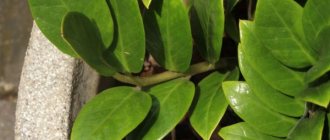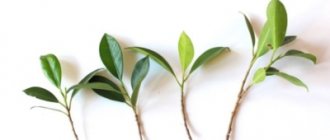Among the variety of Saintpaulia flowers, there are flowers in blue, purple, red and white shades, among which yellow violets stand out. But the name does not fully reflect the color of these beautiful flowers. Breeders have been trying to isolate the yellow color of flowers for several decades, but to no avail. Violets do not have the gene that makes their petals yellow, so those violets that are considered yellow actually have pink pigment.
The most that the breeders managed to do was to develop varieties with lemon-colored veins and a yellow center of the calyx. The yellow pigment acquired as a result of mutations easily dissolves in water, which makes growing such violets a very difficult process. In other varieties that have flowers of other shades, the pigments have a carotene base, which is more durable and gives the flowers a rich color.
Violets with yellow flowers are considered very rare, and their color is not so bright. Another feature of these plants is that when grown at home, the flowers can remain white if care is not taken. Therefore, in order for yellow Saintpaulias to be brighter and not lose their shade, you need to know the features of their content.
Contents of yellow violets
The better the care for violets at home is organized, the better the yellow pigment will appear on the flowers.
Features of watering
Unlike other varieties, yellow-flowered violets are very delicate. Their flowers and leaves react sharply to water. Therefore, top watering must be carried out extremely carefully, avoiding drops of water from falling on the petals. Due to this feature, spraying the plant with water to create the necessary humidity is also excluded. Instead, the pot is placed on a damp tray with expanded clay or gravel.
Features of flowering
If the plant is grown from a rosette or leaf, the first flowering may disappoint the owners.
Yellow flowers appear only in the fourth bloom, then they become more saturated in color. Before this, the yellow tint is almost invisible.
Content temperature
In yellow violets, the saturation of the shade directly depends on temperature conditions. The yellow color appears well only at a temperature of 18 degrees Celsius. This is the lower limit of the temperature range for violets. If the temperature rises, for example, to +25, the flowers will have a faint color, and may even remain completely white. In winter, violets need to be protected from cold air and removed from the windowsill, otherwise the petioles will begin to stretch and the plant will be weakened. Temperature changes will also not benefit these delicate and sensitive plants. Therefore, Saintpaulias kept at home must be protected from drafts and temperature fluctuations.
Lighting
All varieties of yellow Saintpaulia prefer soft and diffused light; it should not be too bright. A good option would be to install fluorescent lamps as a source of additional light.
Plant transplantation
Saintpaulias do not require frequent replanting. It is enough to transplant the violet into a larger pot once a year. This must be done carefully, preferably by transshipment. An earthen ball with roots is placed in a new pot with a drainage layer, and the remaining space is sprinkled with soil. The top around the rosette is covered with moss. This method allows you to practically not injure the root system and minimize stress for the plant.
Feeding
Fertilizers in liquid form are used as fertilizers, which are applied along with watering.
The dose is reduced by half from that recommended in the instructions. When the violet blooms, fertilizing is done every seven days. The amount of phosphorus should be predominant in relation to NPK.
What kind of leaves do Saintpaulias have?
Violets are often called indoor plants, the most diverse in terms of flowering parameters and the most boring in terms of greenery. For some reason, all Saintpaulias are perceived as dark-leaved, velvety-leaved, neatly rosette crumbs. But if you take a closer look not only at the flowering, but also at the greenery, it is obvious that each variety’s leaves are actually special.
More rounded or oval, almost heart-shaped or narrow, with a wide base or a narrow petiole, raised or almost recumbent, small, medium and large, with varying degrees of jagged edges, different shades of green color and the effect of their fluffing...
All Saintpaulias are individual and unique. But by “special leaves” of violets they usually mean either plants with ruffles along the edges (beautiful wavy varieties) or newfangled variegated leaves of the selection.
Unlike the extravagant collectible leaf violets, which bloom inconspicuously and are grown only for their leaves, variegated violets are full-fledged and familiar Saintpaulias, in which variegated leaf colors are added to the “option” of luxurious flowering.
Saintpaulia 'Lucky Penny'. Mildred Rosam
Nuances of care
The presence of peculiarities in the color of leaf blades leads to the need to create slightly different growing conditions for Saintpaulias from the variegated group.
But with a careful study of the requirements of plants, growing them in home collections will not be difficult even for novice gardeners, and contemplation of the decorative properties of variegated leaves will bring real pleasure.
Lighting Features
All variegated Saintpaulias have a dual relationship to the illumination of the room.
A lack of light will negatively affect the general condition of the violet, as it will make it more difficult for the photosynthesis process to take place, which is already much slower in this group.
The plant will receive less nutrients and starve. Also, low lighting of the violet can cause the loss of its variegated color.
Too bright a level of light supply can cause a decrease in the area of the variegated color and a change in the color scheme of the edging from light and white tones to pinkish, yellow and even bronze shades.
ATTENTION! These circumstances should be taken into account when equipping places with additional lighting - daylight spectrum lamps are best placed at some distance from the Saintpaulias.
Based on this, it is necessary to choose the location of the variegated violet of each variety through experienced selection: some varieties develop well on shelves, others bloom only on window sills.
In any case, violets require prolonged illumination with diffused rays - windows facing east and west are suitable for this.
On the windowsills of northern windows, Saintpaulias need lighting, and southern windows with plants will have to be shaded during hot midday periods to avoid overheating and sunburn.
Optimal temperature
All varieties of variegated violets respond gratefully to being kept in rooms with significantly lower temperatures.
Variegated violets do not like high temperatures.
To maintain the brightness and decorativeness of the variegated pattern on the leaf blades of violets, a microclimate with a cool temperature within the range of +18 +20°C is ideal. Higher rates can lead to the disappearance of variegation, changes in leaf shape and slower development.
In the hot months, Saintpaulias will feel more comfortable on northern window sills or on the lower tiers of shelving, provided there is sufficient light. During the cold period, violets should be especially protected from sudden changes in temperature and drafts.
Necessary fertilizers
A slowdown in the process of photosynthesis due to the lack of chlorophyll in a large number of leaf cells and the abundant flowering of variegated violets leads to the need to apply special fertilizers.
As a rule, plants require the following basic chemical elements:
- nitrogen;
- phosphorus;
- potassium;
as well as a complex of microelements included in any fertilizer for indoor crops.
Each life process requires its own feeding:
- phosphorus and potassium are responsible for the formation of buds, flowering and the general condition of violets;
- Nitrogen fertilizers are applied during the growth period to increase the green mass of the plant.
CAREFULLY! Variegated Saintpaulias do not tolerate frequent fertilizing with a high percentage of nitrogen. This element is responsible for the process of production of chlorophyll by the plant: the more nitrogen, the better the green pigment is formed, and this can lead to the disappearance of light patterns on the leaf plates.
Feeding rules
Fertilizing for variegated violets differs in certain nuances, the implementation of which creates comfortable conditions for the plants:
Feeding of adult plants is carried out once a month when the need for the procedure is visually determined;
Fertilize the violet as needed.
- each subsequent procedure must be accompanied by monitoring the percentage of essential elements in accordance with the life phase of the violet;
- young rooted Saintpaulias with a large number of white leaves should be fed more often with nitrogen fertilizers to enhance the green color and improve their nutrition;
- it is necessary to remember that the decorative effect of variegated violets depends on the brightness and volume of the light pattern, and it disappears when overfed with nitrogen;
- To balance the green and light parts of the leaves of adult variegated leaves, you can alternate the percentage of elements in the fertilizer.
Features of care
Varieties of green violets are considered more demanding in terms of maintenance conditions than others. This is explained by the fact that the characteristics of their color are directly related to temperature, lighting conditions and regularity of watering.
In general, violets with green flowers are considered not very demanding plants; the main thing is to follow the basic recommendations for caring for them.
However, among these Saintpaulias one can distinguish green violets, which may be difficult to grow:
- LE-Green Rose;
- RS-Green Lagoon;
- Green dragon;
- RS-Green Corals.
Watering
The watering regime is no different from the norms recommended for other varieties of Saintpaulia.
It is important to water the plants with boiled water at room temperature
Do not allow the soil to overflow or, conversely, dry out. Overmoistening of the soil can lead to the development of fungal diseases of the plant's root system.
Violets should neither be poured nor dried.
It is also recommended to water at the root of the bush, without leaving a drop of water on the surface of the leaves, or to use the wick method of watering.
Air humidity
Increased air humidity will promote regular flowering. You can create it by placing a flower pot on a tray of expanded clay filled with water.
Lighting
Most green violets require intense light due to the rich, dark green color of the foliage.
Those varieties that have a lighter leaf part are able to grow in more shaded conditions.
The most comfortable place to place green violets is considered to be an eastern or western window.
Advice! To ensure uniform formation of the rosette, you need to periodically turn the pot with the plant.
Optimal temperature
The most important criterion influencing the appearance and intensity of green color in Saintpaulia flowers is the temperature regime.
To develop a green tint, violets need to create conditions for a comfortable temperature - no higher than 20 degrees. As it increases, the green color becomes less noticeable, and subsequently disappears completely.
Feeding
Most green violets have wavy foliage, which is a sign of slow plant growth. Therefore, nitrogen-containing fertilizing should be regular and balanced. It is also recommended to ensure that the soil acidity level is close to neutral.
Nematodes.
Nematodes are small, root-bearing, sucking worms armed with a proboscis and with a thread-like body. They cause cone-shaped growths in the form of galls or nodules on the roots. They live in these galls and reproduce there. Damaged plants wither and die as a result of a lack of nutrients absorbed by the nematode. They damage many types of tropical and subtropical crops. In the presence of heat and moisture, they develop all year round, eating the entire root system of the plant.
Control measures. Soil disinfection with chloropicrin, carbon disulfide or hot steam. Quarantine for newly arriving plants. Removal and destruction of affected specimens.
Top ten most popular varieties
The most common, both among experienced flower growers and novice collectors, are:
- The bride's bouquet;
- White Sun of the Desert;
- White mustang;
- White Nights;
- White magic;
- Lady in White;
- Juliet;
- Cotton candy;
- White angel;
- Your Mightiness.
The bride's bouquet
Saintpaulia Bride's Bouquet from the famous breeder Konstantin Morev blooms with large snow-white flowers with wavy petals, and the cream-colored core gives the plant a pearly shine, creating an atmosphere of solemnity.
White Sun of the Desert
The White Sun of the Desert variety blooms with snow-white, smooth, medium-sized flowers that most closely resemble wildflowers.
White mustang
The variety called White Mustang looks no less exotic. A velvet fan-shaped flower with a yellow core and blue splashes in the design of dark green leaves looks unusually delicate.
White Nights
Large light blue semi-double stars with a fantasy color. It is this spectacular flower that is called White Nights, and therefore the plant is classified as a subgroup of white violets. The rosette of Saintpaulia consists of several tiers of dark green, velvety leaves, pointed at the edge.
White magic
The White Magic variety is one of the most spectacular terry Saintpaulias, decorated with fringe. Monochrome – bright white. The rosette is variegated green with whitish veins.
Lady in White
Another unusual type of white palette is Lady in White. Huge, up to 8 centimeters in diameter, double snow-white stars, with petals wavy at the edges. The rosette is small, neat, light green.
Juliet
In addition to plain snow-white violets, varieties with colored inclusions are also extremely popular. Such beauties include, in particular, the Juliet variety.
Large terry stars are white with pink and lilac splashes; their appearance resembles the color of a fantasy. The petals are corrugated, with a fan-shaped edge.
Cotton candy
The peculiarity of the Cotton Candy variety is the abundant flowering of snow-white, voluminous, densely double roses, with corrugated edges of the petals. The rosette consists of wavy, toothed, medium green leaves.
White angel
This sport is somewhat different from other varieties of white. Smooth, light, blue-tinged star-shaped flowers in a rosette design consisting of dark green round leaves.
Your Mightiness
The variety Your Grace is a profusely blooming snow-white rose with fan-shaped double petals and a comb type of flowering. The abundance of dark green leaves makes the flower even more spectacular. This flower will be the highlight of any collection, even for the most experienced and spoiled gardeners.
Varieties and types
In the process of breeding work, various varieties were developed, here are some of them.
- Mellow Yellow. It is considered one of the best representatives of Saintpaulias with yellow flowers. The flowers have a wavy structure along the edges, the color is bright yellow, double flowers in the shape of stars.
- Lemon kiss. This variety has fairly large double flowers of a lemon shade. There is a pink border visible around the edges. The plant looks very delicate, the rosette is compact, and the bouquet is lush.
- Sukissed Rose. This variety has double flowers, shaped like a star, light yellow in color with a yellow center. Shades of pink are visible along the edges of the petals.
In general, caring for Saintpaulias at home is not very different from other representatives of Saintpaulias. But it is worth remembering that yellow-flowered violets are more delicate, and when growing them, you need to take into account the characteristics of these plants. If you follow all the recommendations, yellow-flowered violets will open in all their glory during flowering.
Violets: care and cultivation at home
Although there are a huge number of Saintpaulia varieties, caring for all types is practically no different. And since this crop is considered quite whimsical, cultivation rules must be strictly adhered to.
This video explains how to properly care for Saintpaulias at home.
Location and temperature
This miniflora grows beautifully on all windowsills. For the hot season, the north side is better suited, and in the cold, cloudy period, backlighting is necessary. On the south side, plants may not survive in the summer heat.
Newspaper sheets, blinds and curtains made of thick light fabric (preferably natural) will be a real lifesaver. When exposed to direct sunlight, the leaves get severe burns.
Advice! An extensive collection can be placed on shelves. The shelves can be of any length, but the width is from 30 to 35 cm. So, the pots can be arranged in two rows. When screwing the shelves, keep in mind that a fluorescent lamp will be attached under each of them (at a distance of 15 to 25 cm from the leaves).
For normal growth and development, a comfortable temperature is + 18 – + 25˚C. The highest threshold is + 30˚C, the minimum is + 12˚C.
How to choose soil?
In this matter, flower growers have almost complete carte blanche. The only taboo is fatty, heavy black soil. It is better to give preference to crumbly soil, which allows air and moisture to reach the roots.
Saintpaulia collectors offer several options for soil mixtures:
- 4 liters of peat with vermiculite + 1 tbsp. l. dry mineral fertilizer (5-10-10) + 1 tbsp. l. dolomite flour.
- Leaf + garden soil + sand with sphagnum moss (one part of all components).
- Peat + turf soil (turf is cut in fields and meadows) + manure humus + sand and sphagnum moss (2:1:1/2:1:1). It is recommended to add 1 liter of charcoal and 2 tbsp to a bucket of this mixture. l. dolomite flour and superphosphate.
Important! Violet will grow well in regular purchased Saintpaulia soil.
Watering and air humidity
Experienced gardeners with many years of practice “feel” the plant. Understanding the basics of watering Saintpaulias is not that difficult. The plant consumes the most moisture during the flowering period, in the warm season and with a very developed root system.
Air humidity and soil composition also have a big influence. The lighter it is, the faster it dries. As a rule, they focus on the condition of the top layer. Dry to the touch is warm, and wet is cool to the touch.
Often this is done only through a tray (water is poured into it and the pot is immersed for a while, and when the earthen lump is saturated, the flower is taken out and placed on a cloth). The wick method is also known.
When transplanting, a cord made of synthetic material is threaded through the earthen ball, leading the lower end through the drainage hole of the container.
The first time is watered from above. All subsequent pots are placed on a vessel with water, an improvised cord is lowered into it and they wait until the violet drinks. This is the so-called capillary effect. The water must be settled and warm (+ 30 – 35 degrees).
On especially hot days, the air around the violet is moistened with a spray bottle or the leaves are washed with warm water (the liquid should not get on the flowers).
Feeding and replanting
Special fertilizers for Saintpaulias are sold. They are applied simultaneously with watering every week.
Regarding transplantation, they do this only by transferring it into a plastic pot a couple of centimeters larger than the previous one. The procedure is carried out once a year after flowering (in spring). If the plant does not feel well in the pot or the soil is not selected correctly, an emergency transplant is allowed.
Important! As for pruning, do it only when necessary (if the leaves look drooping and unhealthy).
Growing violets with yellow flowers
Indoor yellow violet: photo
A competent choice of the place in the apartment where the pot of violets will be placed is the key to its successful cultivation. Yellow violets feel best on window sills facing west or east. To ensure that the plant is illuminated evenly, it is recommended to rotate it periodically. In the dark season, the deficit of natural sunlight can be compensated by sources of artificial lighting - this will help prolong the flowering of Saintpaulia.
Sudden temperature changes are dangerous for yellow violets, which prefer to be in a room with a constant room temperature. With the arrival of cold weather, it is better to remove them from the windowsill.
Saintpaulias are very sensitive to watering: water should be at room temperature, watering should be moderate
It is important that the soil in the pot does not dry out, but is also not waterlogged. With the onset of winter, yellow violets need to be watered less frequently and sparingly.
When watering, water should not fall on the petals and leaves of the yellow violet, so it should be poured along the edge of the pot.
In order to increase the air humidity in the room where the yellow violet is located, it is enough to place the pot with the plant on a tray filled with wet pebbles. It is not recommended to spray Saintpaulia.
Yellow violets require fertilization during the flowering period. Fertilizers are applied once every 14 days while watering the plant. A mineral complex rich in phosphorus is best.
Under indoor growing conditions, propagation of yellow violets is carried out by two methods - cuttings and divisions. The first method is considered the most effective. A strong leaf on a stalk about 3 cm long can act as a cutting - it must be placed in water and left there until roots appear. After this, the cutting can be transplanted into a container with soil, deepening it no more than 2 cm. After planting, the cutting needs to be watered with warm water. Such bushes can be replanted no more than once every 12 months. Soil for propagating violets can be purchased at a specialty store.
Violets - varieties, photos, names with descriptions
Saintpaulias are classified as follows - by the size of the rosette and leaves, flowers, shape, color, type of surface and edging of the petals. Each of them stands out from the rest with its individual characteristic features. Sometimes it is difficult to choose among such an assortment, since they all have an attractive appearance, which leaves no one indifferent to the home flowerpot.
Depending on the size of the leaves and rosettes, there are micro, mini, semi-mini and standard. There are also large Saintpaulias, but they are not very popular among home flowerpot lovers. Micro are funny flowers with an average rosette diameter of 5-7 cm. They are bred only in small containers. Mini - 2 times larger than the previous ones, diameter - 10-14 cm. This variety lends itself well to propagation.
Semi mini – 17-19 cm rosette. These do not like very bright lighting. Standard - from 22 to 45 cm in diameter. According to the size of the flowers - small (0.5 - 1.5 cm), medium (1.5 - 3.5 cm), large (3.5 - 6.5 cm). The shape is star, bell, bowl, wasp and Pansy (the common popular name for violets, but this is only a subtype). By color - single and multi-colored. The petals can have different patterns. By surface type – regular (smooth), terry. Not only the leaves are fleecy, but also the petals.
Terry degree – low, medium, large. Based on the edging of the petals, Saintpaulias are distinguished - regular, wavy and fringed.
Important! More than 30,000 varieties of Saintpaulia have been bred in the world - from the most common to rare species (photos are available on the Internet, each has its own article). Even the most sophisticated gourmet can choose the right flower for himself.
What does garden violet mean?
People have been admiring the delicate charm of violets for almost two and a half millennia, but they began to be purposefully grown and propagated to decorate gardens and parks relatively recently:
Violets have recently begun to be grown in gardens.
- In European countries, violet has been known as a garden plant since the beginning of the 16th century;
- In Russia - since the 18th century.
INFORMATIVE! Violets propagated for growing near human habitations are united by flower growers into a conventional group of garden violets. The synonymous series of this group, in addition to the name “Garden Violet”, includes the names “Viola”, “Pansy” and simply “Violet”.
How to care?
White violets, like any other varieties of indoor plants, need proper care, which begins with planting the flower in a pot. In order for the snow-white beauty to take root faster, begin intensive growth and subsequently delight with lush flowering, it should be planted in garden soil mixed with sand, and a drainage layer of expanded clay must be poured onto the bottom of the pot.
Lighting plays a huge role in the development of such flowers: violets love light, but direct sunlight is contraindicated for them. In winter, when the length of the day is shortened, violets need to be additionally illuminated with fluorescent lamps. In addition, the flower must be provided with regular watering, fertilizing, pruning and placed in a room with air humidity of at least 50%.
Temperature
To grow white violets, temperatures ranging from +20 to +22°C are required. The plant is afraid of temperature changes in the room, and if the regime is inconsistent, it may die. Also, high temperatures exceeding +30°C have a bad effect on the development of flowers; under such conditions, their foliage becomes pale and the flowers decrease in size. This plant can also die from drafts.
Top dressing
The main criterion for caring for violets is the timely addition of amino acids, vitamins and microelements to the soil. As fertilizers, only mixtures specially designed for violets should be used. It is recommended to fertilize at least twice a week
It is also important to pay attention to the limitations
Watering
White violets are very capricious when watering. Both a lack and an excess of moisture are dangerous for them. Water procedures are best performed twice a week; this must be done with settled warm water. Many gardeners prefer to moisten flowers in the following way: water is poured into a large tray, pots with plants are placed there, and they are left in the container for half an hour.
Disease Control
If not cared for properly, white Saintpaulia may get sick. Most often it is affected by powdery mildew, rust, late blight and gray rot. At the same time, the most common disease of violets is considered to be powdery mildew, in which a white coating appears on the foliage of the plant. To save the plant from death, they are treated with benthlan and foundationazole. Gray rot is characterized by the appearance of gray spots on all parts of the plant, including the peduncle; to treat the flower, transplant it into new soil and treat it with a fungicide.
As for late blight and rust, they are no less dangerous for violets.
Trimming
Despite its miniature appearance, the white violet needs periodic pruning, thanks to which it acquires a beautiful shape and has three tiers. In addition, pruning is also carried out to remove yellowed foliage from below. Trim (pluck) the plant along the old foliage, leaving the central young rosette intact. If the flower is heavily overgrown with stepsons, they also need to be pulled out or cut out, thus freeing the base.
Pests and diseases
Like any garden plant, violet is susceptible to damage by diseases and pests. The main ones are:
- Stems, leaves and buds are affected by powdery mildew, cobwebs and black spots appear. Treated by spraying with antifungal agents.
- The leaves are affected by spotting, the plant dries out, and the infection can persist even in the seeds. It is necessary to destroy and dig up the bed and treat it with chemicals.
- The base of the stem becomes thinner and darker. This is a black leg. The reason is that the crops are thickened, the lighting and humidity conditions are disrupted. The bed needs to be loosened, thinned and treated against fungus.
- The flowers are covered with gray rot - a fluffy coating with decay. The reason is little light, a lot of moisture and nitrogen. Treatment consists of thinning, ventilation, and fertilization. Chemical treatment is also required.
- In May-June, the plant is affected by the caterpillars of the clover armyworm and pearly violet. It is necessary to spray with tobacco infusion and chlorophos when young caterpillars appear.
Flowers that look like violets
The most famous and popular perennial flowers similar to house violets are:
- Achimenes;
- deikun;
- gloxinia;
- Streptocarpus.
Achimenes
If you see that a flower in a pot looks like a violet, then most likely it is Achimenes. The flowering plant resembles a violet with flowers consisting of five petals.
Achimenes.
A striking similarity is noted in the early period of development of the crop, when the plant has not yet become very elongated and sits in a pot as a strong bush. In adulthood, the culture is ampelous. Achimenes petals can be of different colors. Including:
- purple;
- bluish;
- pink;
- light lilac;
- whitish-purple;
- scarlet, etc.
People who grow violets will find it easy to grow achimenes. Decorative culture requires the same care as violets.
Achimenez will feel great in a bright room, but where there is no direct sunlight. It needs high air humidity. To do this, the flower is often placed in the kitchen area.
It should be watered carefully and no more than three times a week. Warm, settled water is suitable for the procedure. The watering can is not directed at the greens; only the root zone is watered.
Stagnation of water should not be allowed. This will cause rotting of the root system. The pot should have plenty of drainage.
Important! Achimenes does not grow in the winter season. In winter, its aerial part dies off, and the pineal rhizome rests.
Deikun
The more famous name of the flower is Cinderella's Dream. The ruffled semi-double edges of the neat petals are reminiscent of a ball gown. This flower is a representative of a new selection of violets. The edges of the petals, which have a terry-net structure, stand out in color from the main petal.
Usually the petal is snow-white in color, and the corrugated edges are covered with a lilac, pink, purple or lilac border. The leaves are moderately velvety, curved-wavy in shape. The upper part of the leaf blade is emerald, the lower part is brick or reddish-green.
Violet Cinderella's dream (Deikun).
Deikun does not tolerate cold, heat, direct sunlight, darkness, or drafts. It is best to keep it in a lighted, ventilated room, where it is about +19…+23 degrees. The soil substrate must be loose. The soil should be moistened every 2 days.
Gloxinia
A violet that looks like a bell is gloxinia, an ornamental crop that resembles a violet with its leaf blades. They are round, slightly elongated, strong. Light velvety pubescence and light veins are noticeable. Leaf color is green.
Gloxinia (close-up photo of the flower).
The leaves do not form rosettes, like those of a violet, but grow tightly to each other. The color range of gloxinia is extensive. The prevailing petal colors are:
- lilac-lilac;
- scarlet;
- pink;
- snow-white, etc.
The plant prefers to be in a bright place with diffused bright lighting. The air should not be dry. Otherwise, the stem and leaves with flowers will wither.
Like violets, gloxinia should not be sprayed with water from a spray bottle. To humidify the air, it is recommended to place a container of water in the room. Due to the inadmissibility of drops getting on the green mass, gloxinia should be watered at the root or pour water into a pan.
Gloxinia needs hibernation every year. The dormant period begins in the fall. At this time, the bush is pruned, and the pot is placed in the basement or underground, where it is dark and cool.
Tubers need moisture even in winter. They should be watered once every 20-35 days.
Advice! The culture is responsive to feeding. It is recommended to apply mineral fertilizers to the soil every 50 days, which contain no nitrogen or very little of it.
Streptocarpus
A bright decorative specimen that attracts attention with its fancy miniature neat flowers. The color can be very different - from blue, dark burgundy to snow-white and pinkish. Streptocarpus
Streptocarpus.
This indoor plant blooms in the summer. For good growth, a lighted place is necessary. It would be ideal to place it on a windowsill facing east.
The plant is resistant to short-term drought and quickly recovers after watering. It is best to water it every 2-3 days through a tray. In winter it goes to rest.
Propagation of violets at home
Many people grow violets at home. This is not as difficult as it might seem at first glance.
Using seeds
You can grow Saintpaulia from seeds. This is done like this:
- The seeds are laid out in a shallow container with moist soil. A greenhouse is created there, which needs to be regularly ventilated and watered.
- When the seeds sprout, they can be planted in a deeper container. You just need to be careful - the roots of the flower are very delicate and thin. When the seedling gets stronger, it is ready to be transplanted into a pot.
Through cuttings
It is more common to propagate violets from cuttings, that is, from a leaf. It is cut off with a sharp knife and rooted in water with an activated carbon tablet. The container is covered with polyethylene (with perforations to remove condensation). When the leaf takes root, it can be transplanted directly into the pot. At the same time, for the first time he also needs to set up a greenhouse.
Leaf propagation
Other ways
You can grow Uzambara violet in other ways:
- Children. A baby is a shoot from a violet cutting with its own roots. It is recommended to select only one, the largest baby, cut it off with a knife and plant it in a separate pot.
- Stepsons. The stepson, or daughter rosette, is a process that originates in the axils of the leaves. It spoils the appearance, so it should be removed. The removed stepson can be rooted in water, then planted in its own pot.
When does flowering occur after planting?
If we are talking about adult bushes transplanted into another pot:
- transshipment does not require removal of buds;
- When the earthen clod is destroyed, the flower stalks are torn off; it takes from 2 to 5 weeks for new ones to form in the axils of the leaves, plus time for the full formation and opening of the corollas.
The first flower stalks need to be removed, leaving one to check whether the violet has sprung. And after opening the corolla, immediately tear it off so as not to weaken the bush.
Some Saintpaulias manage to acquire buds when the daughter rosettes are not yet separated from the mother leaf or immediately after transplanting into individual cups. The flower stalks on them need to be removed; if this is not done, in the future the bushes will bloom poorly and the violets will grow weak.
On planted stepsons, buds appear when rosettes of the same variety grown from leaves, minus 1.5-3 months spent on rooting and germination. When the violet rejuvenates, the top produces buds as soon as the sucking shoots entwine the clump.
Top 10 most popular varieties
EK-Green Apples
A special feature of this variety is its densely double flowers with light green outer petals. The center of the flower is blue.
The leaves are deep green. When kept in cool conditions, the flower shows its shades more vividly.
PC-Green Corals
Features simple blue-white stars bordered with bright green fringe.
The foliage of this violet variety is ruffled, shiny, and medium green. Large leaves often have a gnarled shape. Due to the dense, twisted foliage, the rosette cannot acquire a beautiful shape.
The flowers are dense and have an unusual ultramarine color. A bluish-colored border surrounds the edges of the petals. The shade of the flower petals and border can be of different saturation.
The process of blooming buds takes a long time, some of them do not have time to fully bloom. Blooming flowers last for about a month.
Attention! The plant is not distinguished by frequent and lush flowering. Next to very large leaves, small flowers look lonely.
AB-Cupid
A showy variety with white single or semi-double pansies, with a slight pinkish tint and a bright green ruffled edge.
The foliage is quite large, shiny, bubbly, and medium green. a pink tint on the white petals of the flower appears in conditions of elevated temperature.
Violet is characterized by abundant and long-lasting flowering. Many small flowers on strong, stable peduncles cover the plant with a “cap”.
This variety is distinguished by its unpretentiousness and fertility.
Fronzen in Time
A surprisingly delicate variety that has white cupped flowers resembling stars, which are bordered by a rich green rim.
The plant is valued for its long flowering. The flowers sometimes take on a lavender color.
The foliage is variegated green and white.
EK-Malachite orchid
Its large double flowers have a rich cherry color with a wide green border around the edges.
Under the influence of low ambient temperatures, the color of the violet becomes almost completely green, leaving only the cherry middle.
The leaves of the rosette are distinguished by their pointed shape. Flowering duration is about 3 months. The buds are usually collected in bouquets.
The variety is characterized by intensive growth and unpretentiousness.
LE-Green Rose
The flowers of this variety resemble pansies, are painted in a soft pink color, and the edges of the petals are framed with a green fringe. The foliage has a wavy shape and a glossy shine.
The border is green in just opening buds; then, as the flower opens, it turns yellow, and then completely loses color, turning white.
Flowering bouquet. Does not have a long flowering period. Fast growing variety.
Green Horizon
The flowers of this variety of Saintpaulia are double stars of white color, with wide stripes of green along the edges of the petals. The foliage is medium green.
The saturation of green color in the petals of the bud manifests itself with the age of the rosette - the older it is, the larger and richer the flowers look.
Important! This green-white violet boasts abundant and long-lasting blooms, a fast growth rate and ease of propagation.
Allegro Pink Pistachio
A chic semi-miniature variety, distinguished by double herbaceous green rosettes bordered by a crimson-red frill.
The foliage is light green in color, has a shiny surface and an elongated shape.
Flowering is almost continuous. A unique, incomparable variety.
RS-Miracle Lily of the Valley
The flowers of this variety of violet delight with their simplicity and tenderness.
They have the shape of a pink bell with a light green fringe along the edges of the petals. The bud never opens completely, hence the similarity to the lily of the valley.
The foliage is standard, light green. Flowering is long and abundant.
Features of flowering, growth and reproduction
The varieties grow quite quickly, but the first flowering can be expected in about a year. The rosette forms independently, and even on window sills produces a fairly even and symmetrical bush.
Reproduction of this Saintpaulia is not particularly difficult, because there are no external factors that would exclude some methods.
The plant blooms profusely, regardless of conditions. The flower stalks are quite thick, smooth and raised above the foliage, forming a beautiful cap, almost every flowering.
Attention! In the Winter Rose variety, there is a tendency for flower stalks to fall on the leaves, but this process is not regular.
The buds last a very long time. It may take two weeks from full bloom to drying of the flower, but this is average.
Depending on the temperature, the color may change slightly:
- In cool conditions, the contrast between the main tone and the back of the petals is much brighter;
- And in the heat the inside becomes darker.











